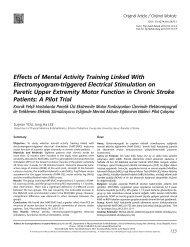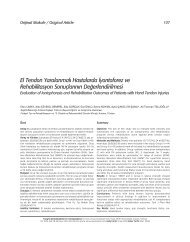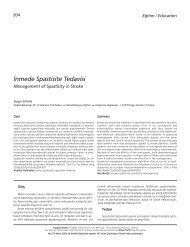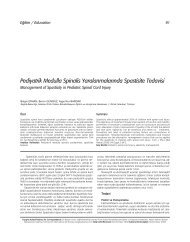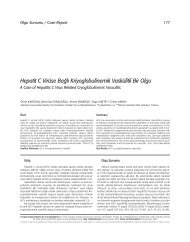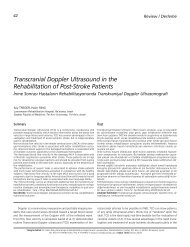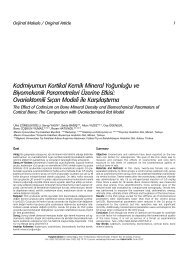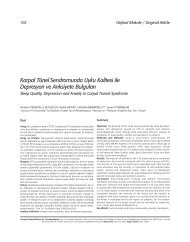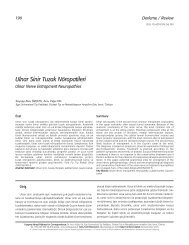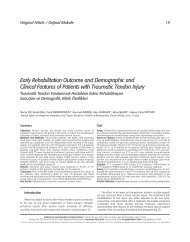Lumbar Stabilization Exercises in Addition to ... - FTR Dergisi
Lumbar Stabilization Exercises in Addition to ... - FTR Dergisi
Lumbar Stabilization Exercises in Addition to ... - FTR Dergisi
You also want an ePaper? Increase the reach of your titles
YUMPU automatically turns print PDFs into web optimized ePapers that Google loves.
Orig<strong>in</strong>al Article / Orij<strong>in</strong>al Makale<br />
DO I: 10.4274/tftr.22438<br />
<strong>Lumbar</strong> <strong>Stabilization</strong> <strong>Exercises</strong> <strong>in</strong> <strong>Addition</strong> <strong>to</strong> Strengthen<strong>in</strong>g<br />
and Stretch<strong>in</strong>g <strong>Exercises</strong> Reduce Pa<strong>in</strong> and Increase Function<br />
<strong>in</strong> Patients With Chronic Low Back Pa<strong>in</strong>: Randomized Cl<strong>in</strong>ical<br />
Open-Label Study<br />
Kronik Bel Ağrılı Hastalarda Güçlendirme ve Germe Egzersizler<strong>in</strong>e Ek Olarak Yapılan<br />
Lomber Stabilizasyon Egzersizleri Ağrıyı Azaltır ve Fonksiyonu Arttırır: Randomize<br />
Açık Kl<strong>in</strong>ik Çalışma<br />
Anita STANKOVIC, Milica LAZOVIC*, Mirjana KOCIC, Lidija DIMITRIJEVIC, Ivona STANKOVIC, Dragan ZLATANOVIC, Irena DIMITRIJEVIC**<br />
Cl<strong>in</strong>ic for Physical Medic<strong>in</strong>e and Rehabilitation, Cl<strong>in</strong>ical Center Nis, Nis, Serbia<br />
*Institute for Physical Medic<strong>in</strong>e and Rehabilitation Sokobanjska, Belgrade, Serbia<br />
**Institute for Rehabilitation Niska Banja, Niska Banja, Serbia<br />
Sum mary<br />
Objective: <strong>Lumbar</strong> stabilization exercises aim <strong>to</strong> activate and strengthen the<br />
deep abdom<strong>in</strong>al and back muscles. Exercise program presented <strong>in</strong> this study<br />
comb<strong>in</strong>es activation of specific lumbar stabiliz<strong>in</strong>g muscles with traditional<br />
strengthen<strong>in</strong>g and stretch<strong>in</strong>g exercises. The ma<strong>in</strong> goal of this study was <strong>to</strong><br />
establish the effect of stabilization exercises on pa<strong>in</strong> reduction and improv<strong>in</strong>g<br />
functionality <strong>in</strong> patients with Chronic Low Back Pa<strong>in</strong> (CLBP).<br />
Materials and Methods: This prospective randomized cl<strong>in</strong>ical study was<br />
conducted <strong>in</strong> the Cl<strong>in</strong>ical Center Nis, from January 2007 until March 2009.<br />
160 patients with CLBP were eligible and met the <strong>in</strong>clusion criteria. The<br />
study group (S; n=100) had specific lumbar stabilization exercises, while<br />
the patients <strong>in</strong> the control group (C; n=60) performed traditional program<br />
for CLBP, based on the strengthen<strong>in</strong>g and stretch<strong>in</strong>g of the large, superficial<br />
back muscles. For moni<strong>to</strong>r<strong>in</strong>g the patients, the Oswestry Disability Index<br />
(ODI) and Short-form 36 (SF-36) were used.<br />
Results: After the therapy, pa<strong>in</strong> was successfully reduced <strong>in</strong> both groups<br />
with higher statistical significance <strong>in</strong> the study group (p
178<br />
Stankovic et al.<br />
<strong>Exercises</strong> for Low Back Pa<strong>in</strong><br />
Introduction<br />
Chronic Low Back Pa<strong>in</strong> (CLBP) is a very common and<br />
widespread health problem. Eighty percent of the world’s<br />
population experiences it, at least once <strong>in</strong> their lifetime (1).<br />
Besides pa<strong>in</strong> and functional disability, CLBP is characterized by<br />
psychological and socio-economic aspects. Therefore, the<br />
treatment requires a multidiscipl<strong>in</strong>ary approach and it should be<br />
directed not only <strong>to</strong> reduce pa<strong>in</strong>, but also <strong>to</strong> improve quality of<br />
life parameters (2,3).<br />
The ma<strong>in</strong> pathophysiological cause of CLBP is mechanical<br />
lumbar syndrome, typically aggravated by static load<strong>in</strong>g of the<br />
sp<strong>in</strong>e (prolonged sitt<strong>in</strong>g or stand<strong>in</strong>g), by long-lever activities or<br />
levered postures (bend<strong>in</strong>g forward, rotation of the trunk, etc.).<br />
It <strong>in</strong>cludes: nonspecific pa<strong>in</strong>, probably caused by<br />
macro<strong>in</strong>stability or micro<strong>in</strong>stability of the sp<strong>in</strong>e with or without<br />
radiographic hypermobility or evidence of subluxation (4-6);<br />
followed by: <strong>in</strong>tervertebral disc degeneration arthropathy of,<br />
facet jo<strong>in</strong>ts and surround<strong>in</strong>g structures, sp<strong>in</strong>al canal stenosis,<br />
spondylosis and spondylolisthesis. Less than 1% could be due<br />
<strong>to</strong> nonmechanical syndromes: neurologic syndromes, systemic<br />
disorders and referred pa<strong>in</strong> (7,8).<br />
In order <strong>to</strong> provide an adequate therapy for CLBP, it is<br />
necessary <strong>to</strong> establish pa<strong>in</strong> <strong>in</strong>tensity and patient’s functional<br />
status. Before decid<strong>in</strong>g what exercise program <strong>to</strong> apply, it is<br />
important <strong>to</strong> check for any restrictions <strong>in</strong> mobility and pa<strong>in</strong><br />
occurrence dur<strong>in</strong>g the execution of several selected basic<br />
stabilization exercises and also <strong>to</strong> <strong>in</strong>vestigate whether there are<br />
some limitations <strong>in</strong> activities of daily liv<strong>in</strong>g (3,9).<br />
Positive effects of exercise therapy on pa<strong>in</strong> and functionality<br />
<strong>in</strong> patients with CLBP had been proven by cl<strong>in</strong>ical practice and<br />
numerous studies (10-12). Traditional exercise programs for<br />
CLBP <strong>in</strong>clude strengthen<strong>in</strong>g and stretch<strong>in</strong>g of the large<br />
superficial back and abdom<strong>in</strong>al muscles, without stabilization<br />
exercises and formation of the protective lumbar muscle corset.<br />
The lack of such programs is the <strong>in</strong>ability <strong>to</strong> activate deepest layers<br />
of the back muscles, as well as <strong>in</strong>adequate pelvis immobilization,<br />
which can lead <strong>to</strong> <strong>in</strong>jury dur<strong>in</strong>g exercise (9,12-14).<br />
First stabilization exercise program was presented by<br />
Richardson et al. (12) <strong>in</strong> 1999. They emphasized the need for<br />
special exercise program, which would enable activation of<br />
particular muscles of the lower back <strong>in</strong> order <strong>to</strong> stabilize lumbar<br />
region and decrease pa<strong>in</strong> and disability. This specific exercise<br />
program, better known as segmental stabilization exercises,<br />
does not preclude the need for strengthen<strong>in</strong>g and stretch<strong>in</strong>g<br />
aerobic exercises. Applied alone, any lumbar stabiliz<strong>in</strong>g<br />
maneuver is not sufficient for full recovery of function and<br />
reduction of pa<strong>in</strong>, but it can be an essential addition <strong>to</strong> any<br />
traditional exercise program (10,11,13,15,16).<br />
Basic Hypothesis (Research Question)<br />
Is there a difference <strong>in</strong> rehabilitation outcome, <strong>in</strong> relation <strong>to</strong><br />
the level of pa<strong>in</strong> and functionality, when lumbar stabilization<br />
exercises are <strong>in</strong>cluded <strong>in</strong><strong>to</strong> the standard k<strong>in</strong>esitherapy pro<strong>to</strong>col<br />
for CLBP?<br />
Objective<br />
To establish the effectiveness of comb<strong>in</strong>ed lumbar<br />
stabilization exercise program for pa<strong>in</strong> reduction and<br />
improvement of overall quality of life <strong>in</strong> patients with CLBP,<br />
compared <strong>to</strong> the traditional exercise program.<br />
Materials and Methods<br />
Turk J Phys Med Re hab 2012;58:177-83<br />
Türk Fiz T›p Re hab Derg 2012;58:177-83<br />
The research was designed as a prospective, randomized,<br />
open-label study. At the eligibility-screen<strong>in</strong>g visit, the patients<br />
underwent a prelim<strong>in</strong>ary assessment <strong>to</strong> accus<strong>to</strong>m <strong>to</strong> the<br />
assessment procedures.<br />
Eligibility criteria:<br />
1. Low back pa<strong>in</strong>,<br />
2. 18 <strong>to</strong> 75 years old,<br />
3. With no severe functional and cognitive deficiency (<strong>to</strong> be<br />
able <strong>to</strong> walk, bend down, sit and stand alone; able <strong>to</strong> understand<br />
and perform demonstrated exercise),<br />
4. More than six months from any surgical <strong>in</strong>tervention,<br />
especially neurosurgical <strong>in</strong>terventions (herniated disc, sp<strong>in</strong>al<br />
canal narrow<strong>in</strong>g etc),<br />
The results of this assessment were not used dur<strong>in</strong>g analysis.<br />
F<strong>in</strong>al statistical analysis <strong>in</strong>cluded 160 CLBP patients, who met the<br />
eligibility and <strong>in</strong>clusion criteria (Figure 1).<br />
Inclusion criteria for participation were:<br />
• Low back pa<strong>in</strong> that lasted more than 12 weeks, vary<strong>in</strong>g <strong>in</strong><br />
<strong>in</strong>tensity and irradiation, from mild <strong>to</strong> very strong,<br />
• Functional limitations <strong>in</strong> perform<strong>in</strong>g certa<strong>in</strong> activities of<br />
everyday liv<strong>in</strong>g: dress<strong>in</strong>g, lift<strong>in</strong>g heavy objects, walk<strong>in</strong>g, runn<strong>in</strong>g,<br />
sitt<strong>in</strong>g, stand<strong>in</strong>g, sleep<strong>in</strong>g, etc.<br />
Exclusion criteria were:<br />
• Proven acute radiculopathy (ENMG) or severe pa<strong>in</strong> below<br />
the knee (cl<strong>in</strong>ical exam<strong>in</strong>ation and <strong>in</strong>terview),<br />
• Inability <strong>to</strong> perform isometric muscle contractions or <strong>to</strong> be<br />
exposed <strong>to</strong> medium level of physical exertion due <strong>to</strong> some<br />
<strong>in</strong>ternal illness (cardiovascular, pulmonary, systemic etc.),<br />
• Some neurological illness (stroke, polyneuropathy),<br />
• Lack of understand<strong>in</strong>g of the study (dementia, language<br />
problems),<br />
• Drug or alcohol abuse.<br />
The patients were treated <strong>in</strong> the Cl<strong>in</strong>ic for Physical Medic<strong>in</strong>e<br />
and Rehabilitation, Cl<strong>in</strong>ical Center Nis, from January 2007 until<br />
March 2009. The study was evaluated and approved by the<br />
Scientific and Ethics Committee of the Faculty of Medic<strong>in</strong>e<br />
University of Nis, Nis, Serbia. All patients gave their written<br />
consent for participation <strong>in</strong> the study.<br />
There was no f<strong>in</strong>ancial support by any <strong>in</strong>stitution or<br />
organization.<br />
The patients were recruited consecutively from the outpatient<br />
department of the Cl<strong>in</strong>ic and assigned <strong>to</strong> one or the other exercise<br />
program on the basis of “Even-Odd” co<strong>in</strong>cidence rule: first served<br />
patient had traditional k<strong>in</strong>ezitherapy program, second served had<br />
stabilization exercises, third aga<strong>in</strong> traditional, etc.<br />
The authors were not <strong>in</strong>cluded <strong>in</strong> the first recruitment<br />
process (eligibility and randomization), and that was as far as<br />
concealment procedure went. We ma<strong>in</strong>ta<strong>in</strong> the view that for
Turk J Phys Med Re hab 2012;58:177-83<br />
Türk Fiz T›p Re hab Derg 2012;58:177-83<br />
exercise therapy, concealment procedure is not applicable. It is<br />
the matter of great importance that the attend<strong>in</strong>g physician is<br />
<strong>in</strong>volved <strong>in</strong> every segment of exercise therapy with CLBP<br />
patients, <strong>in</strong> order <strong>to</strong> provide: <strong>in</strong>formation, education, <strong>to</strong> plan<br />
type and level of exercises, <strong>to</strong> control and moni<strong>to</strong>r the way<br />
prescribed exercises are performed.<br />
Study Group (SG) <strong>in</strong>cluded 100 patients with CLBP (60<br />
female and 40 male, mean age: 49.5±11.8 years). Patients<br />
attend<strong>in</strong>g this group had a comb<strong>in</strong>ed exercise program that<br />
<strong>in</strong>cluded sp<strong>in</strong>al segmental stabilization exercises. The program<br />
consisted of 15 exercises, designed <strong>to</strong> comb<strong>in</strong>e isometric<br />
contraction of stabiliz<strong>in</strong>g muscles of the lower back, abdom<strong>in</strong>al<br />
wall and the pelvic floor, with aerobic set of exercises for CLBP.<br />
Each session began <strong>in</strong> a stand<strong>in</strong>g position. After several<br />
relaxation and breath<strong>in</strong>g exercises, the patients were given<br />
<strong>in</strong>structions how <strong>to</strong> form stabiliz<strong>in</strong>g corset by jo<strong>in</strong>t isometric<br />
contraction of the multifidus and transversus abdom<strong>in</strong>is muscles<br />
(4,13,15,17). The verification of the achieved stabilization was<br />
carried out by the therapist and the patients themselves,<br />
palpat<strong>in</strong>g the contracted muscles. The participants learned how<br />
<strong>to</strong> ma<strong>in</strong>ta<strong>in</strong> and properly quantify achieved contractions while<br />
do<strong>in</strong>g simple exercises. After the <strong>in</strong>itial stabilization tra<strong>in</strong><strong>in</strong>g, the<br />
patients were ready <strong>to</strong> beg<strong>in</strong> with strengthen<strong>in</strong>g and stretch<strong>in</strong>g<br />
aerobic exercises (15,18). The program was performed <strong>in</strong><br />
stand<strong>in</strong>g, sitt<strong>in</strong>g, kneel<strong>in</strong>g and ly<strong>in</strong>g positions. Dur<strong>in</strong>g the<br />
exercises, the patients were try<strong>in</strong>g <strong>to</strong> keep their trunk and pelvic<br />
girdle <strong>in</strong>active. The program consisted of different sets of<br />
exercises such as: pelvic elevation (bridg<strong>in</strong>g), abdom<strong>in</strong>al tra<strong>in</strong><strong>in</strong>g<br />
(curl-ups), mixed extension/flexion stretch of the sp<strong>in</strong>al column<br />
(cat-camel), hook-ly<strong>in</strong>g (posterior pelvic <strong>in</strong>cl<strong>in</strong>ation), etc. We<br />
also <strong>in</strong>cluded exercises on unstable support (Swiss Ball), <strong>in</strong> order<br />
<strong>to</strong> improve proprioception, coord<strong>in</strong>ation and balance (19-21).<br />
Control Group (CG) consisted of 60 patients with CLBP (37<br />
female, 23 male; mean age 49.5±12.4). Their treatment was<br />
carried out accord<strong>in</strong>g <strong>to</strong> traditional Regan-Michelle’s pro<strong>to</strong>col,<br />
strengthen<strong>in</strong>g and stretch<strong>in</strong>g aerobic exercises, without pelvic<br />
immobilization and core stabilization. The program was<br />
designed <strong>to</strong> activate the large muscle groups <strong>in</strong> the superficial<br />
layer of the lower back and abdomen <strong>in</strong> order <strong>to</strong> improve overall<br />
muscle strength and endurance.<br />
All subjects had a <strong>to</strong>tal of 20 therapeutic treatments, for 4<br />
weeks (5 days per week). Each treatment lasted 30 m<strong>in</strong>utes.<br />
The Oswestry Disability Index (ODI) (22,23) was selected <strong>to</strong><br />
evaluate the functional ability. General <strong>in</strong>formation<br />
(demographics, social and mental status) and overall health<br />
issues of the participants were gathered by the SF-36 Health<br />
Survey (24,25).<br />
All data were collected before and after the therapy.<br />
Entry, spreadsheet and graphical display of data were<br />
performed us<strong>in</strong>g MS Excel program. Calculations were carried out<br />
by SPSS, version 15.0. Descriptive parameters are presented as<br />
frequencies and percentages, while cont<strong>in</strong>uous (measurable)<br />
variables are presented as mean values (X) and Standard<br />
Deviations (SD). To compare the frequency of certa<strong>in</strong> descriptive<br />
variables Pearson's chi square test was used. Yates's correction and<br />
Fisher’s exact test were also applied, because of the sample size.<br />
Student’s t-test for paired variables was used <strong>to</strong> exam<strong>in</strong>e<br />
changes <strong>in</strong> cont<strong>in</strong>uous variables after therapy, and t-test for<br />
unpaired variables was used <strong>to</strong> exam<strong>in</strong>e cont<strong>in</strong>uous variables<br />
differences between groups. Relations between parameters were<br />
Table 1. Demographics (SF-36).<br />
Characteristic Study group Control group<br />
Number of patients 100 60<br />
Age (years) 49.5±11.8 49.5±12.4<br />
Height (cm) 170.6±8.7 170.8±9.6<br />
Weight (kg)<br />
Sex (%)<br />
76.8±14.6 75.2±10.4<br />
Male 40 38.3<br />
Female<br />
Education (%)<br />
60 61.7<br />
Elementary 6.7 15<br />
High school 68.3 58<br />
College 10 16<br />
Postgraduate<br />
Relationships (%)<br />
0 2<br />
Alone 13.3 12<br />
Married 71.7 72<br />
Liv<strong>in</strong>g with someone 8.3 8<br />
Divorced<br />
Work (%)<br />
3.3 4<br />
Work<strong>in</strong>g 37.3 27.3<br />
Sick leave dur<strong>in</strong>g therapy 13.6 13.1<br />
Unemployed<br />
Location of pa<strong>in</strong> (%)<br />
Primary / Secondary<br />
18.6 6.2<br />
Low back 100 100<br />
Neck - right 38 46.7<br />
Neck - left 34 35<br />
Hip - right 32 36.67<br />
Hip - left 36 31.67<br />
Table 2. Assessment of low back pa<strong>in</strong> <strong>in</strong> both groups, before and after the<br />
therapy.<br />
Study group Control group<br />
before after before after<br />
Pa<strong>in</strong> assessment 3.13±1.30 2.03±1.18 ***a 3.22±1.29 2.77±1.36*<br />
In group (after vs. before): *** − p
180<br />
established us<strong>in</strong>g Pearson’s coefficient of l<strong>in</strong>ear correlation (r). A<br />
p value less than 0.05 was considered statistically significant.<br />
Results<br />
Stankovic et al.<br />
<strong>Exercises</strong> for Low Back Pa<strong>in</strong><br />
The SF-36 was used for demographics and quality of life<br />
parameters (Table 1; Figure 2, 3).<br />
There was no statistically significant difference between the<br />
groups before the therapy.<br />
Pa<strong>in</strong><br />
Before the therapy, pa<strong>in</strong> was assessed as moderate <strong>in</strong> both<br />
groups, with no statistically significant difference between them.<br />
After the therapy, pa<strong>in</strong> was successfully reduced <strong>in</strong> both groups<br />
(p
Turk J Phys Med Re hab 2012;58:177-83<br />
Türk Fiz T›p Re hab Derg 2012;58:177-83<br />
the SG with the CG, there was statistically less sleep disturbance<br />
<strong>in</strong> the SG (p
182<br />
Stankovic et al.<br />
<strong>Exercises</strong> for Low Back Pa<strong>in</strong><br />
recorded <strong>in</strong> the CG. Positive effects were observed <strong>in</strong> all aspects<br />
of function<strong>in</strong>g, rang<strong>in</strong>g from patients general health status<br />
through emotional state, <strong>to</strong> pa<strong>in</strong> reduction and functional<br />
recovery. We also established a high correlation between pa<strong>in</strong><br />
and disability parameters, which can lead us <strong>to</strong> conclude that by<br />
fight<strong>in</strong>g disability we can significantly decrease pa<strong>in</strong>.<br />
In order <strong>to</strong> compare our results with others, we reviewed a<br />
large number of studies that addressed this issue and came across<br />
various results. Some of them match with ours (9,12,13,15,16),<br />
and some do not (14,26), but it was very difficult <strong>to</strong> compare<br />
them, because of the different methodologies, functional tests and<br />
questionnaires that were used. This diversity was confirmed by the<br />
systematic literature review conducted by Ferreira et al. (27) who<br />
found stabilization exercises <strong>to</strong> be effective if applied <strong>in</strong> a<br />
controlled and selective manner.<br />
Richardson et al. (12) presented the first exercise program<br />
for strengthen<strong>in</strong>g the transversus abdom<strong>in</strong>is and multifidus<br />
muscles. The program was based on the assumption that the<br />
greater power and endurance of these muscles could affect the<br />
stability of the lumbar sp<strong>in</strong>e as a whole, and thereby, reduce<br />
pa<strong>in</strong> and <strong>in</strong>crease overall functional ability. They emphasized the<br />
simultaneous activation of the transversus abdom<strong>in</strong>is and<br />
multifidus by isometric contractions of these muscles, before and<br />
dur<strong>in</strong>g the execution of various aerobic exercises. A similar<br />
pr<strong>in</strong>ciple was applied <strong>in</strong> our study.<br />
Three years later, the same authors (17), demonstrated the<br />
biomechanical effects of transversus abdom<strong>in</strong>is muscle<br />
strengthen<strong>in</strong>g on sacroiliac jo<strong>in</strong>t stability, which is often associated<br />
with the stability of lumbar region as a whole. <strong>Exercises</strong> for the<br />
sacroiliac jo<strong>in</strong>t were also <strong>in</strong>cluded <strong>in</strong> our program.<br />
In studies that followed compared stabilization exercise<br />
programs with different physical procedures <strong>in</strong> order <strong>to</strong> f<strong>in</strong>d the<br />
best available therapy for CLBP (8,10,11), the results were<br />
diverse. O'Sullivan et al. (28) were among the first authors who<br />
compared specially designed stabilization program with<br />
traditional aerobic exercises. Their study showed that patients,<br />
who performed specifically designed stabilization exercises<br />
program, had significantly better results <strong>in</strong> pa<strong>in</strong> reduction and<br />
functional ability compared <strong>to</strong> the patients who did not have<br />
stabilization exercises. They also confirmed the durability of<br />
these effects by conduct<strong>in</strong>g a control exam<strong>in</strong>ation after 30<br />
months. The same authors (18) conducted a series of studies<br />
with similar outcome on patients with spondylosis and<br />
spondylolisthesis, as proven entities of lumbar sp<strong>in</strong>e <strong>in</strong>stability.<br />
Hayden et al. (11) conducted a meta-analysis that <strong>in</strong>cluded 6390<br />
patients. From 61 studies, 43 were related <strong>to</strong> chronic lumbar pa<strong>in</strong>.<br />
Compar<strong>in</strong>g 72 different exercise programs, authors concluded that<br />
best effects were achieved with <strong>in</strong>dividually and carefully designed<br />
exercise programs, which would comb<strong>in</strong>e stabilization and<br />
strengthen<strong>in</strong>g exercises, dosed <strong>to</strong> suit each <strong>in</strong>dividual case.<br />
Only a small number of studies directly compared<br />
stabilization exercises with other exercise programs (4,15,16).<br />
Our study was most similar <strong>to</strong> the prospective randomized study<br />
published <strong>in</strong> 2005 by Koumantakis et al. (15). Authors<br />
Turk J Phys Med Re hab 2012;58:177-83<br />
Türk Fiz T›p Re hab Derg 2012;58:177-83<br />
compared the effects of traditional strengthen<strong>in</strong>g exercises for<br />
low back pa<strong>in</strong> with that of comb<strong>in</strong>ed stabilization, strengthen<strong>in</strong>g<br />
and stretch<strong>in</strong>g exercise program, based on the activation of the<br />
multifidus and transversus abdom<strong>in</strong>is. The program had a<br />
gradual progression <strong>in</strong> <strong>in</strong>tensity and complexity of the given<br />
exercises and lasted eight weeks. This study supported both<br />
programs giv<strong>in</strong>g a m<strong>in</strong>imum advantage <strong>to</strong> the comb<strong>in</strong>ed<br />
stabilization and strengthen<strong>in</strong>g exercise regimen. Koumantakis<br />
et al. concluded that the best results were achieved <strong>in</strong> patients<br />
with proven lumbar <strong>in</strong>stability (by roentgenograms of the<br />
lumbar sp<strong>in</strong>e region <strong>in</strong> normal position and maximal flexion,<br />
extension and rotation). The necessity of <strong>in</strong>dividualized and<br />
multi-discipl<strong>in</strong>ary approach was clearly emphasized.<br />
From the end of our study <strong>in</strong> May 2009 <strong>to</strong> date, there were<br />
not many similar studies which could be compared with this<br />
one. A systematic review conducted by Macedo LG et al. (29),<br />
published <strong>in</strong> 2009 sheds some light on the matter and supports<br />
this k<strong>in</strong>d of mo<strong>to</strong>r control exercises suggest<strong>in</strong>g their<br />
effectiveness and benefit <strong>to</strong> another form of <strong>in</strong>tervention <strong>in</strong><br />
reduc<strong>in</strong>g pa<strong>in</strong> and disability for CLBP patients, under some<br />
conditional circumstances: <strong>to</strong> f<strong>in</strong>d an optimal implementation of<br />
this k<strong>in</strong>d of exercises, <strong>to</strong> properly evaluate dosage, <strong>to</strong> def<strong>in</strong>e the<br />
subgroups of patients with the same <strong>in</strong>dications and <strong>to</strong> try <strong>to</strong><br />
comb<strong>in</strong>e it with feedback and cognitive <strong>in</strong>terventions.<br />
There are many new studies compar<strong>in</strong>g some exercise<br />
programs <strong>to</strong> others try<strong>in</strong>g <strong>to</strong> f<strong>in</strong>d the best possible pro<strong>to</strong>col for<br />
these patients. Dufour et al. (30) compared group-based<br />
multidiscipl<strong>in</strong>ary biopsychosocial rehabilitation and <strong>in</strong>tensive<br />
<strong>in</strong>dividual therapist-assisted back muscle strengthen<strong>in</strong>g<br />
exercises. Both programs were very effective and could be used<br />
<strong>in</strong> comb<strong>in</strong>ation <strong>in</strong> order <strong>to</strong> achieve the best possible results.<br />
Unsgaard-Tondel et al. (26) compared mo<strong>to</strong>r control exercises<br />
(similar <strong>to</strong> stabilization) and sl<strong>in</strong>g exercises with general<br />
exercises for CLBP and found no evidence that first two were<br />
better <strong>in</strong> any way than traditional general exercise regimen.<br />
Rasmussen-Barr et al. (31) found that graded exercise<br />
<strong>in</strong>tervention, emphasiz<strong>in</strong>g stabiliz<strong>in</strong>g exercises, for patients with<br />
recurrent LBP were more effective <strong>in</strong> improv<strong>in</strong>g disability and<br />
overall health parameters than other exercise regimens, but with<br />
no positive results regard<strong>in</strong>g pa<strong>in</strong>.<br />
Review<strong>in</strong>g these and many other research studies and<br />
publications, all we can say without fail is that this subject is far<br />
from closed and there is a large open space for further<br />
<strong>in</strong>vestigations. Many authors comb<strong>in</strong>e exercises with cognitive<br />
and behavioral <strong>in</strong>terventions, which may be the best approach<br />
<strong>to</strong> this complex health problem.<br />
Our experiences show that complete exercise program for<br />
CLBP is the one that comb<strong>in</strong>es stabilization techniques with<br />
specific and <strong>in</strong>dividually dosed aerobic exercises. That k<strong>in</strong>d of<br />
exercise program enables patients <strong>to</strong> rega<strong>in</strong> full functionality, <strong>to</strong><br />
decrease level of pa<strong>in</strong> and <strong>to</strong> prevent further <strong>in</strong>juries of the<br />
lumbar sp<strong>in</strong>e.<br />
Limitations<br />
The ma<strong>in</strong> limitation of the presented study is the lack of<br />
objectivity <strong>in</strong> evaluat<strong>in</strong>g gathered data. Used test and survey
Turk J Phys Med Re hab 2012;58:177-83<br />
Türk Fiz T›p Re hab Derg 2012;58:177-83<br />
show only subjective view of patients symp<strong>to</strong>ms. ENMG could<br />
be used as objective <strong>to</strong>ol for stabiliz<strong>in</strong>g muscle strength and<br />
endurance measurement was used only <strong>in</strong> <strong>in</strong>itial stage of the<br />
study as exclusion method for detection of radiculopathy,<br />
peroneal and tibial palsy. This can lead <strong>to</strong> some difficulties<br />
regard<strong>in</strong>g reproducibility and generalization of our study.<br />
However, we emphasized that improvement of patients<br />
symp<strong>to</strong>ms was our only goal <strong>in</strong> this research and we found that<br />
decrease <strong>in</strong> pa<strong>in</strong> and <strong>in</strong>crease of functionality, which have such<br />
substantial statistical importance, could not be dismissed on the<br />
basis of subjectivity, ma<strong>in</strong>ly because pa<strong>in</strong> and quality of life are<br />
subjective parameters.<br />
Conclusion<br />
Specifically designed stabilization exercises program <strong>in</strong><br />
comb<strong>in</strong>ation with strengthen<strong>in</strong>g and stretch<strong>in</strong>g aerobic<br />
exercises had positive effect on pa<strong>in</strong> reduction, functionality and<br />
quality of life parameters <strong>in</strong> patients with CLBP.<br />
With high statistical significance, we showed that comb<strong>in</strong>ed<br />
stabilization program was more effective <strong>in</strong> all tested aspects<br />
compared <strong>to</strong> the traditional exercises for CLBP.<br />
Conflict of Interest:<br />
Authors reported no conflicts of <strong>in</strong>terest.<br />
References<br />
1. DeRosa CP, Porterfield JA. A physical therapy model for the treatment of low<br />
back pa<strong>in</strong>. Phys Ther 1992;72:261-72.<br />
2. Koes BW, van Tulder MW, Ostelo R, Kim Bur<strong>to</strong>n A, Waddell G. Cl<strong>in</strong>ical<br />
guidel<strong>in</strong>es for the management of low back pa<strong>in</strong> <strong>in</strong> primary care: an<br />
<strong>in</strong>ternational comparison. Sp<strong>in</strong>e (Phila Pa 1976) 2001;26:2504-13.<br />
3. Brox JI, S<strong>to</strong>rheim K, Holm I, Friis A, Reikerås O. Disability, pa<strong>in</strong>, psychological<br />
fac<strong>to</strong>rs and physical performance <strong>in</strong> healthy controls, patients with subacute<br />
and chronic low back pa<strong>in</strong>: a case-control study. J Rehabil Med<br />
2005;37:95-9.<br />
4. Akuthota V, Nadler SF. Core strengthen<strong>in</strong>g. Arch Phys Med Rehabil 2004;85<br />
(Suppl 1):86-92.<br />
5. Panjabi MM. Low back pa<strong>in</strong> and sp<strong>in</strong>al <strong>in</strong>stability. In: We<strong>in</strong>ste<strong>in</strong> JN, Gordon<br />
SL, eds. Low back pa<strong>in</strong>: a scientific and cl<strong>in</strong>ical overview. Rosemont, III:<br />
American Academy of Orthopedic Surgeons 1996:367-84.<br />
6. Panjabi MM, White AA 3rd. Basic biomechanics of the sp<strong>in</strong>e. Neurosurgery<br />
1980;7:76-93.<br />
7. Deyo R, We<strong>in</strong>ste<strong>in</strong> J. Low back pa<strong>in</strong>. N Engl J Med 2001;344:363-70.<br />
8. Wheeler AH. Diagnosis and management of low back pa<strong>in</strong> and sciatica. Am<br />
Fam Physician 1995;52:1333-48.<br />
9. Nelson BW, O’Reilly E, Miller M, Hogan M, Wegner JA, Kelly C. The cl<strong>in</strong>ical<br />
effects of <strong>in</strong>tensive, specific exercises on chronic low back pa<strong>in</strong>: a controlled<br />
study of 895 consecutive patients with 1-year follow-up. Orthopedics<br />
1995;18:971-81.<br />
10. Hayden JA, van Tulder MW, Toml<strong>in</strong>son G. Systematic review: strategies for<br />
us<strong>in</strong>g exercise therapy <strong>to</strong> improve outcomes <strong>in</strong> chronic low back pa<strong>in</strong>. Ann<br />
Intrern Med 2005;142:776-85.<br />
Stankovic et al.<br />
<strong>Exercises</strong> for Low Back Pa<strong>in</strong><br />
183<br />
11. Hayden JA, van Tulder MW, Malmivaara AV, Koes BW. Meta-analysis:<br />
exercise therapy for nonspecific low back pa<strong>in</strong>. Ann Intern Med<br />
2005;142:765-75.<br />
12. Richardson CA, Jull GA, Hides JA. Therapeutic exercise for low back pa<strong>in</strong>:<br />
scientific bases and cl<strong>in</strong>ical approach, 1st ed. UK: Churchill Liv<strong>in</strong>gs<strong>to</strong>ne<br />
1999;9-20.<br />
13. McGill SM, Grenier S, Kavcic N, Cholewicki J. Coord<strong>in</strong>ation of muscle<br />
activity <strong>to</strong> assure stability of the lumbar sp<strong>in</strong>e. J Elec<strong>to</strong>myogr K<strong>in</strong>esiol<br />
2003;13:353-9.<br />
14. Caims MC, Foster NE, Wright C. Randomized controlled trial of specific<br />
sp<strong>in</strong>al stabilization exercises and conventional physiotherapy for recurrent<br />
low back pa<strong>in</strong>. Sp<strong>in</strong>e (Phila Pa 1976) 2006;31:670-81.<br />
15. Koumantakis GA, Watson PJ, Oldham JA. Trunk muscle stabilization tra<strong>in</strong><strong>in</strong>g<br />
plus general exercise versus general exercise only: randomized controlled<br />
trial of patients with recurrent low back. Phys Ther 2005;85:209-25.<br />
16. Roh<strong>in</strong>i K, Gaurav T, S<strong>in</strong>gh SJ. Comparison of effects of specific stabilization<br />
exercises and conventional back extension exercises <strong>in</strong> management of<br />
chronic disc prolapse. Indian J Physiother Occup Ther 2007;1:2007-9.<br />
17. Richardson CA, Snijders CJ, Hides JA, Damen L, Pas MS, S<strong>to</strong>rm J. The relation<br />
between the transversus abdom<strong>in</strong>is muscles, sacroiliac jo<strong>in</strong>t mechanics and<br />
low back pa<strong>in</strong>. Sp<strong>in</strong>e (Phila Pa 1976) 2002;27:399-405.<br />
18. O’Sullivan P, Twomey L, Garry A. Evaluation of specific stabiliz<strong>in</strong>g exercise <strong>in</strong><br />
the treatment of chronic low back pa<strong>in</strong> with radiologic diagnosis of<br />
spondylolysis or spondylolisthesis. Sp<strong>in</strong>e 1997;22:2959-67.<br />
19. Marshall PW, Murphy BA. Core stability exercises on and off a Swiss ball.<br />
Arch Phys Med Rehabil 2005;86:242-9.<br />
20. Cariere B. The "Swiss ball". An effective <strong>to</strong>ol <strong>in</strong> physiotherapy for patients,<br />
families and physiotherapists. Physiother 1999;85:552-61.<br />
21. Vera-Garcia FJ, Grenier SG, McGill SM. Abdom<strong>in</strong>al muscle response dur<strong>in</strong>g<br />
curl-ups on both stable and labile surfaces. Phys Ther 2000;80:564-9.<br />
22. Fairbank JC, Pynsent PB. The Oswestry Disability Index. Sp<strong>in</strong>e (Phila Pa<br />
1976) 2000;25:2940-52.<br />
23. Davidson M, Keat<strong>in</strong>g JL. A comparison of five low back disability<br />
questionnaires: reliability and responsiveness. Phys Ther 2002;82:8-24.<br />
24. Ware JE Jr. SF-36 health survey update. Sp<strong>in</strong>e (Phila Pa 1976)<br />
2000;25:3130-9.<br />
25. Brazier JE, Harper R, Jones NM, O'Catha<strong>in</strong> A, Thomas KJ, Usherwood T, et<br />
al. Validat<strong>in</strong>g the SF-36 health survey questionnaire: new outcome<br />
measures for primary care. BMJ 1992;305:160-4.<br />
26. Unsgaard-Tøndel M, Fladmark AM, Salvesen O, Vasseljen O. Mo<strong>to</strong>r control<br />
exercises, sl<strong>in</strong>g exercises and general exercises for patients with chronic low<br />
back pa<strong>in</strong>: a randomized controlled trial with 1-year follow-up. Phys Ther<br />
2010;90:1426-40.<br />
27. Ferreira PH, Ferreira ML, Maher CG, Herbert RD, Refshauge K. Specific<br />
stabilisation exercise for sp<strong>in</strong>al and pelvic pa<strong>in</strong>: a systematic review. Aust J<br />
Physiother 2006;52:79-88.<br />
28. O’Sullivan P, Twomey L, Allison G. Dysfunction of the neuro-muscular<br />
system <strong>in</strong> the presence of low back pa<strong>in</strong> - Implications for physical therapy<br />
management. J Man Manip Ther 1997;5:20-6.<br />
29. Macedo LG, Maher CG, Latimer J, McAuley JH. Mo<strong>to</strong>r control exercise for<br />
persistent, nonspecific low back pa<strong>in</strong>: a systematic review. Phys Ther<br />
2009;89:9-25.<br />
30. Dufour N, Thamsborg G, Oefeldt A, Lundsgaard C, Stender S. Treatment of<br />
chronic low back pa<strong>in</strong>: a randomized, cl<strong>in</strong>ical trial compar<strong>in</strong>g group-based<br />
multidiscipl<strong>in</strong>ary biopsychosocial rehabilitation and <strong>in</strong>tensive <strong>in</strong>dividual<br />
therapist-assisted back muscle strengthen<strong>in</strong>g exercises. Sp<strong>in</strong>e (Phila Pa<br />
1976) 2010;35:469-76.<br />
31. Rasmussen-Barr E, Äng B, Arvidsson I, Nilsson-Wikmar L. Graded exercise<br />
for recurrent low-back pa<strong>in</strong>: a randomized, controlled trial with 6-, 12-, and<br />
36-month follow-ups. Sp<strong>in</strong>e (Phila Pa 1976) 2009;34:221-8.



